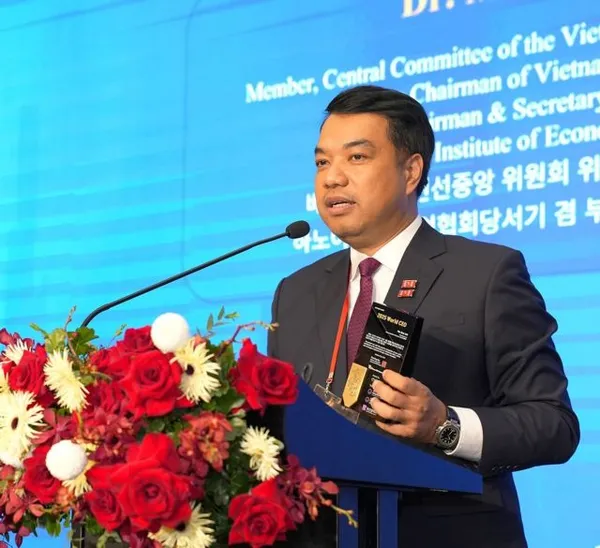 Talking Shop
Talking Shop

 |
| Lê Việt Nga, Deputy Director of the Domestic Market Department. |
Vietnamese businesses exhibit notable dynamism as they are actively engaging in various international connection and trade promotion initiatives overseas. In a conversation on the sidelines of the Vietnamese Week in Thailand 2023 organised by Central Retail Vietnam in Bangkok last week, Lê Việt Nga, Deputy Director of the Domestic Market Department under the Ministry of Industry and Trade (MoIT), spoke with Việt Nam News reporter Mai Hương about the essential prerequisites that enterprises must fulfil to successfully introduce Vietnamese goods to foreign markets.
Have you seen an enhancement in Vietnamese enterprises’ confidence over the years through their engagement in trade connection events?
One of the most intriguing developments has been the evolving consumer inclination toward Vietnamese products within the domestic market thanks to the campaign “Vietnamese people give priority to using Vietnamese products”. This shift has led to the establishment of more robust connections between supply and demand, thereby facilitating the global expansion of Vietnamese goods. It's worth noting that foreign investment has also played a pivotal role in fostering this transformative phenomenon.
These interactions encompass sustainable methodologies for introducing products into diverse markets, aligning with retail systems present in Việt Nam and extending to international domains. Different markets have distinct traits. Foreign Direct Investment (FDI) retail distribution systems in Việt Nam organise specialised buying teams for procuring goods, offering comprehensive guidelines to streamline procedures.
The process involves adhering to specific conditions for successful integration into various systems tailored to destination countries. That’s why Vietnamese businesses continually engage in these events, using them as a platform to gauge signals and assess consumer potential within expansive distribution networks like Centara in Bangkok, catering to Thai consumers.
This trend extends beyond Thailand's Central Retail system, encompassing global entities like South Korea's Lotte, Thailand's MM Mega Market and Japan's Aeon, each with distinctive brands. This dynamic channel proves highly effective in facilitating cross-border trade.
Despite active engagement in numerous networking events, the count of businesses able to secure official export contracts with foreign distribution systems remains limited. What underlies this limitation, and how can Vietnamese products be enhanced if distributors request goods under their brand?
The approach involves a gradual upgrading campaign. Initially, Vietnamese products are integrated into the distribution systems of foreign enterprises within the domestic market. This serves as the foundational step, followed by brand processing. Brands like Aeon's "Top Value", Lotte's "Choice L" and others owned by MM Mega Market and Central Retail are emblematic examples. This progression equips Vietnamese businesses with insights into product quality and packaging that resonate with consumers, aligning with their preferences and evolving market trends. This journey also imparts an understanding of year-by-year consumption patterns in these markets.
Furthermore, Vietnamese enterprises must intensify investments in cultivating their own brands, establishing a distinct presence within these systems. This marks the subsequent phase. As Việt Nam gains familiarity with exporting goods to foreign distribution systems, larger orders necessitate organised production processes. This includes investments in capital and technology, which may be a big challenge to medium and small businesses. In this realm, big enterprises typically secure the majority of official orders.
For instance, prominent Vietnamese brands like Trung Nguyên coffee and Vinamilk have successfully exported their distinctive identities. Conversely, small and medium businesses require time for growth. This development entails the crucial provision of state capital and specific support to help businesses fulfill quality and quantity requirements, which entails substantial investments to enhance product excellence, packaging and design, aligning with consumer preferences.
Businesses have shared that while foreign buyers express interest in their products, they face obstacles related to export documentation, procedural intricacies and substantial transportation costs. To address these challenges, what specific policies has MoIT formulated to support business?
MoIT stands out as the most proactive ministry in the current foreign market, vigorously supporting trade promotion, fostering supply-demand connections and facilitating negotiations. This proactive stance enables Vietnamese enterprises to integrate into foreign systems and establish trade partnerships.
However, for comprehensive support regarding processes such as certification, product origin, packaging and design, the collaboration of other ministries and branches might be necessary. For instance, the Ministry of Science and Technology and the Ministry of Agriculture and Rural Development, each possessing their areas of expertise, could play vital roles. Industry and Trade programmes designed to bolster industrial and commercial product chains are often initiated for negotiation purposes. In practice, when buyers arrive, other relevant departments contribute, especially when it comes to enabling smaller enterprises to meet high standards, particularly the demanding technical benchmarks of certain markets.
Green products have become an undeniable trend to access foreign markets. Do you believe Vietnamese enterprises are adequately equipped to meet this demand? How can they enhance their capacity to enter this market, and what government policies are in place to support startups with innovative ideas but limited capital and market knowledge?
Certainly, bringing Vietnamese products to surmount this "green barrier" demands a substantial effort. The universal trend toward sustainability requires changes in production and obtaining green certifications. While this concept is relatively new in Việt Nam, international organisations evaluating products for their country's market requirements are limited, necessitating broader dissemination of information across businesses of all scales. Cooperation among agencies, especially state management bodies, is vital in offering guidance, communication and training to enterprises. Encouraging businesses to adopt environmentally friendly packaging and designs requires careful consideration.
The process of transitioning towards eco-friendly practices faces challenges. For instance, transitioning from non-biodegradable packaging to recyclable alternatives has been gradual, taking around a decade. Manufacturers have also been slow in adopting environmentally conscious packaging. While these changes take time, they're essential for creating a more sustainable environment.
MoIT has already introduced a comprehensive green growth strategy and action plans, aligned with the Prime Minister's directives. This strategy emphasises promoting environmentally friendly products that align with consumer trends. Demonstrations are carried out in modern distribution systems like supermarkets and commercial centres to educate the public about green consumption and products.
MoIT has been a pioneer in green practices, investing over a decade in biofuel conversion, with E5 gasoline now prevalent across all gas stations in Việt Nam. Future plans involve expanding efforts in areas like electric cars, which have gained traction within the Vietnamese automobile industry. However, collaborative efforts from other ministries and sectors are anticipated to further drive the development of distribution systems that prominently feature a growing percentage of green products. — VNS




